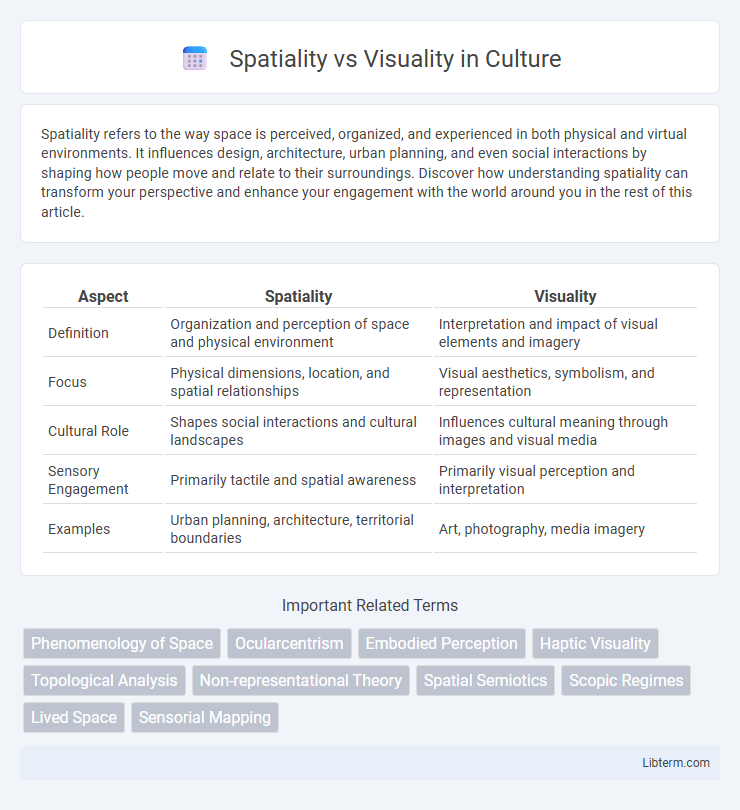Spatiality refers to the way space is perceived, organized, and experienced in both physical and virtual environments. It influences design, architecture, urban planning, and even social interactions by shaping how people move and relate to their surroundings. Discover how understanding spatiality can transform your perspective and enhance your engagement with the world around you in the rest of this article.
Table of Comparison
| Aspect | Spatiality | Visuality |
|---|---|---|
| Definition | Organization and perception of space and physical environment | Interpretation and impact of visual elements and imagery |
| Focus | Physical dimensions, location, and spatial relationships | Visual aesthetics, symbolism, and representation |
| Cultural Role | Shapes social interactions and cultural landscapes | Influences cultural meaning through images and visual media |
| Sensory Engagement | Primarily tactile and spatial awareness | Primarily visual perception and interpretation |
| Examples | Urban planning, architecture, territorial boundaries | Art, photography, media imagery |
Understanding Spatiality: Definition and Core Concepts
Spatiality refers to the qualities and dimensions of space in which objects, events, or phenomena exist and interact, emphasizing the organization, distribution, and relationships within physical or conceptual environments. Core concepts of spatiality include proximity, scale, orientation, and the relational positioning that influence how spaces are perceived and utilized. Understanding spatiality involves analyzing how spatial arrangements affect behavior, communication, and meaning within contexts such as architecture, geography, and digital environments.
What is Visuality? Terminology and Theories
Visuality refers to the ways in which visual perception and interpretation shape our understanding of the world, emphasizing the cultural, social, and psychological dimensions of seeing. The term is rooted in theories from scholars like Martin Jay and W.J.T. Mitchell, who explore how vision is not merely biological but mediated through power, ideology, and representation. Visuality intersects with semiotics and critical theory, analyzing how images convey meaning and influence knowledge production within specific spatial and historical contexts.
Historical Perspectives: Space and Sight Through the Ages
Historical perspectives on spatiality and visuality reveal evolving relationships between space and sight, influenced by cultural, technological, and philosophical shifts. In ancient times, space was often conceived through cosmological frameworks, with sight emphasizing symbolic and hierarchical orientations, while the Renaissance introduced linear perspective, revolutionizing spatial perception by aligning visuality with geometric principles. Modern and contemporary theories explore spatiality as dynamic and multidimensional, challenging traditional visual dominance by incorporating sensory and experiential dimensions beyond mere sight.
Spatiality in Architecture and Urban Design
Spatiality in architecture and urban design emphasizes the organization and experience of physical space, shaping how people navigate and interact within environments. It involves the manipulation of volume, scale, and proportion to create meaningful spatial relationships that influence social behavior and movement patterns. Effective spatial design supports functionality and connectivity, enhancing the sense of place and community in both buildings and urban areas.
Visuality in Art and Media
Visuality in art and media refers to the ways visual perception shapes our understanding and interpretation of imagery, emphasizing the role of light, color, and composition in conveying meaning. It explores how visual elements influence audience engagement and narrative construction, highlighting the impact of perspective, framing, and visual rhetoric. This concept extends to digital media, where screens and interfaces mediate visual experiences, transforming traditional artistic expression and consumption.
Intersections: Where Spatiality Meets Visuality
The intersection of spatiality and visuality reveals how physical environments shape visual perception and interaction, creating immersive experiences that blend three-dimensional space with visual stimuli. This convergence enhances spatial awareness through visual cues, enabling more intuitive navigation and meaningful engagement with surroundings. Understanding these intersections is critical in fields such as architecture, urban design, and virtual reality, where spatial dynamics influence visual interpretation and user experience.
Cognitive Impacts: How We Perceive Space and Visuals
Spatiality influences cognitive processing by enabling individuals to understand and navigate environments through spatial memory and mental mapping. Visuality impacts cognition by shaping attention, perception, and interpretation of visual stimuli, which affects decision-making and emotional responses. Together, spatial and visual cognition interact to form a comprehensive understanding of space, facilitating spatial awareness and visual recognition in everyday experiences.
Technological Influences: VR, AR, and Digital Environments
Technological advancements in VR, AR, and digital environments have transformed spatiality by creating immersive, interactive spaces that transcend physical limitations, allowing users to experience three-dimensional environments with enhanced depth and presence. Visuality in these technologies leverages high-resolution graphics, real-time rendering, and spatial audio to heighten sensory perception, shaping how digital content is perceived and interpreted. The convergence of spatiality and visuality in VR and AR blurs the boundary between virtual and real worlds, enabling dynamic interactions and fostering new modes of spatial awareness through digital interfaces.
Debates and Discourses: Scholars on Spatiality vs Visuality
Scholars debating spatiality versus visuality emphasize how spatiality encompasses the lived experience and social relations within a given environment, contrasting with visuality's focus on perception and representation through sight. The discourse probes into how spatial frameworks influence identity and power dynamics, while visuality interrogates the role of images and visual technologies in shaping knowledge and cultural meaning. Key figures, such as Henri Lefebvre on spatial theory and Michel Foucault on visual regimes, highlight the intersection yet divergence between spatial experience and visual perception in critical theory.
Future Directions: Evolving Relationships Between Space and Vision
Future directions in spatiality and visuality embrace immersive technologies such as augmented reality (AR) and virtual reality (VR), which reshape the perception and interaction with spatial environments. Advanced AI-powered spatial mapping enables dynamic visualization that adapts to user context, enhancing spatial cognition and experience. Innovations in multisensory integration and real-time environmental data processing are driving new paradigms where space and vision co-evolve to create seamless, interactive spatial-visual ecosystems.
Spatiality Infographic

 libterm.com
libterm.com